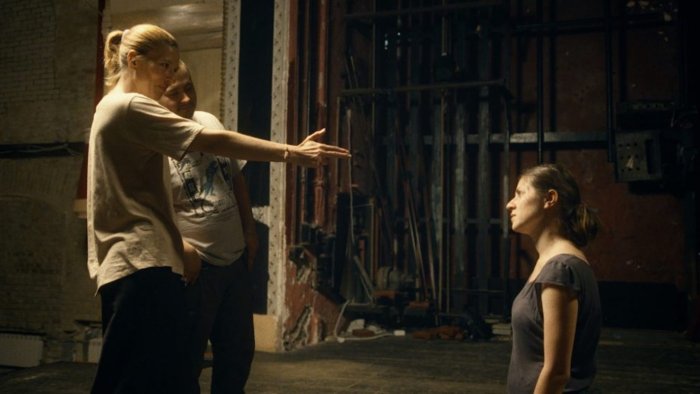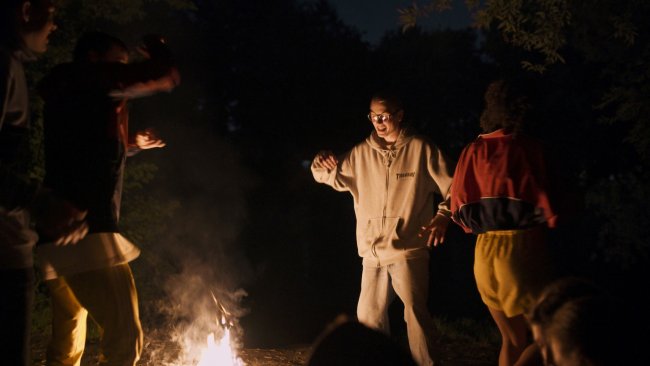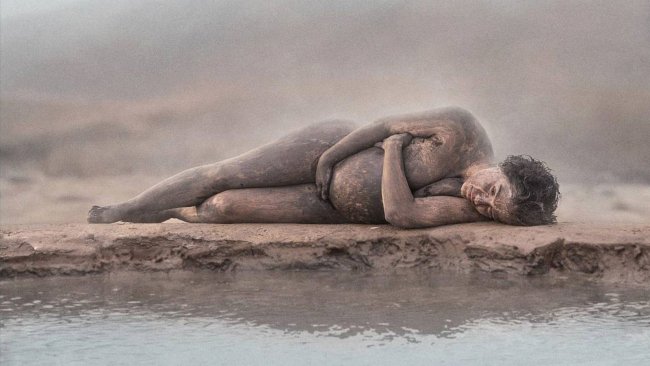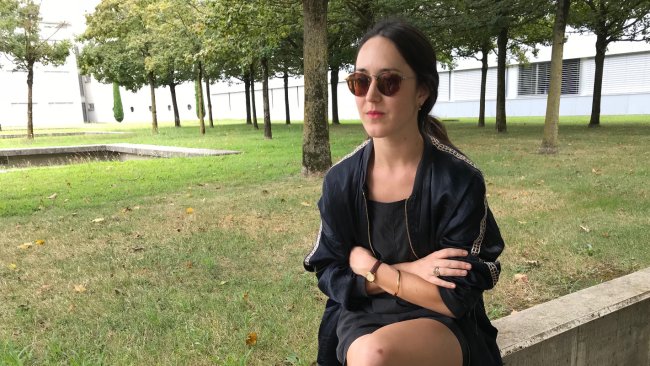The Hamlet Syndrome
[…] Recollected trauma purged, embodied and witnessed in the rehearsal room for the creation of uncompromising images for two different audiences: a theatre audience immediate to their own pain and a film audience mostly far from this tragedy.
[…] The film adroitly captures this wide-spread tension between differing positions on the war at a tiny scale with an intimately tied group of people surviving (or not) the internal and external conflict between patriotism, identity and ideology.
Text: Jodie McNeilly

The opening images of the Hamlet Syndrome remind us that war in Eastern Ukraine has devastated this region much longer than the rest of the world has paid attention to. We see a masked woman sitting in a gutter littered with rubble. Less than a metre away, a wall of soldiers, clad head to toe in black, hold long metal shields, waiting, ready to be unleashed upon the unarmed who might resist. Her diminutive, dwarfed figure is defiant against the backdrop of this Medieval frontline. The image is symbolic of the impact this territorial squabble has on civilians who are both willing and unwilling participants in actions that detrimentally reshape their lives. They are individuals forced to experience the dilemma of choosing to fight or not, to save Ukraine or themselves, to live or die.
Film makers Elwira Niewiera and Piotr Rosolowski observe the devising processes of a small contemporary theatre group in the Donetsk region a few months before Putin’s full-scale military invasion earlier this year. Six people explore the personal and national scars of their participation in the 2013-2014 war: two soldiers (Katya Kotliarova and Slavik Gavianets), two actors (Oxana Cherkashyna and Roman Kryvdyk, who also served in the war effort), one stylist (Rodion Shuygin-Grekalov, a queer person fighting on another front for LGBT rights) and director Rosa Sarkisian. The production engages with the key dilemma of Shakespeare’s most famous tragic hero Hamlet, expressed in the opening lines of his soliloquy in Act III, Scene 1: «To be or not to be». It is the existential meaning of these lines that the devising process utilises, enticing the performers to open up about horrific moments in the war. Recollected trauma purged, embodied and witnessed in the rehearsal room for the creation of uncompromising images for two different audiences: a theatre audience immediate to their own pain and a film audience mostly far from this tragedy.
Raised in a country with ties to the British Empire through colonisation where Shakespeare is integral to one’s literary and dramatic education, I am at a loss as to understand why the experiences of these young people in war could be unlocked through the character of Hamlet whose madness from revenge is born of privilege and power. The title of the film, The Hamlet Syndrome, while different to the theatre work, seems also inappropriate, if associating “feigning”, “faking” or “malingering” with the mental state of these young people. Roman’s therapy session, Slavik’s tears, Oxana’s crises of relevance viscerally undermine the idea; however, this might not be its meaning, or Hamlet is more exotic to this part of the world than I am giving him credit for.
If the figure of Hamlet, understood to be the “every[hu]man” is one of many departure points for this contemporary devising process, then the very human dilemma of being able to choose one’s death, rather than «suffer the slings and arrows of outrageous fortune» is an efficacious place to begin, but absurdist plays of a different tradition, such as Samuel Beckett, Tadeusz Różewicz or even Jon Fosse, spring to mind as worthy catalysts for such questioning.
In an early exercise, Sarkisian directs the group to “imagine” they are Hamlet with his difficult choices and speak words that represent how they feel about the choices they have made. Such an approach has the effect of sublimating the self through character without complete disassociation, enabling a safe enough distance from the rawness of the trauma, but it is also dangerous, fraught, as some of the actors break down or become enraged. There is bravery and trust. Heroes of the rehearsal room rather than battlefield. Heightened tensions are calmed in therapeutic tones.
Devising, along with the documentary’s emphasis on making, holds deep resonance with Playback Theatre. A highly participatory and process driven approach, playback focuses upon personal storytelling by audience members who, in an «atmosphere of safety and respect», will talk about a painful or joyful memory to heal the shared wounds of a community or nation through the particular. The aestheticised model of playback relates to Victor Turner’s anthropological idea of the “Social Drama” where an individual crisis is redressed through public and performative consultation.
The playback approach consists of several devices: witnessing, improvisation, self-reflexivity and storytelling. The Hamlet Syndrome project uses these with obvious success to create a production where the audience - while not speaking themselves - feels, shares, witnesses and reflects on their own experiences of the war through that of the performers.
The film ends with the final scene of the live performance that was contentious among the cast during development. The civilian soldiers who patriotically chose to defend their country were challenged by the project’s critique of Ukraine; its politics and traditions all symbolically designated in a giant flag. The flag as prop is used in provocative and irreverent ways by the actress who did not fight, did not deliberate on whether she would choose death over suffering at the hands of the Russian soldiers, and will flee to the West. The film adroitly captures this wide-spread tension between differing positions on the war at a tiny scale with an intimately tied group of people surviving (or not) the internal and external conflict between patriotism, identity and ideology.
What the rehearsal and production could not show, the film is able to deliver with extreme tenderness and poignancy. Observing the performers’ and families’ struggles with their choices to fight, be openly queer, or follow a career brings a degree of normalcy to the surreal nature of war. While characterised by the heaviness and fear of losing a child to war, these discussions resemble any parental concern of losing a child to adulthood as they separate themselves through the choices they make. The film also manages to mitigate the numbing effect of anonymisation in war. Every soldier has a family – the enemy too – who miss, worry about and mourn their children.
Paradoxically, Niewiera and Rosolowski possess an invasive yet gentle filming style that pushes us into the intensity of the moment while holding and caressing us with their humanity. I look forward to delving into their back catalogue and seeing what’s on the horizon.
This article contains a third-party video. If you would like to watch the video, please adjust your settings.
Watch
Screenings at the Human Rights Film Festival Zurich 2022
Info
The Hamlet Syndrome | Film | Elwira Niewiera, Piotr Rosolowski | PL-DE 2022 | 85’ | Locarno Film Festival 2022
First published: August 15, 2022



